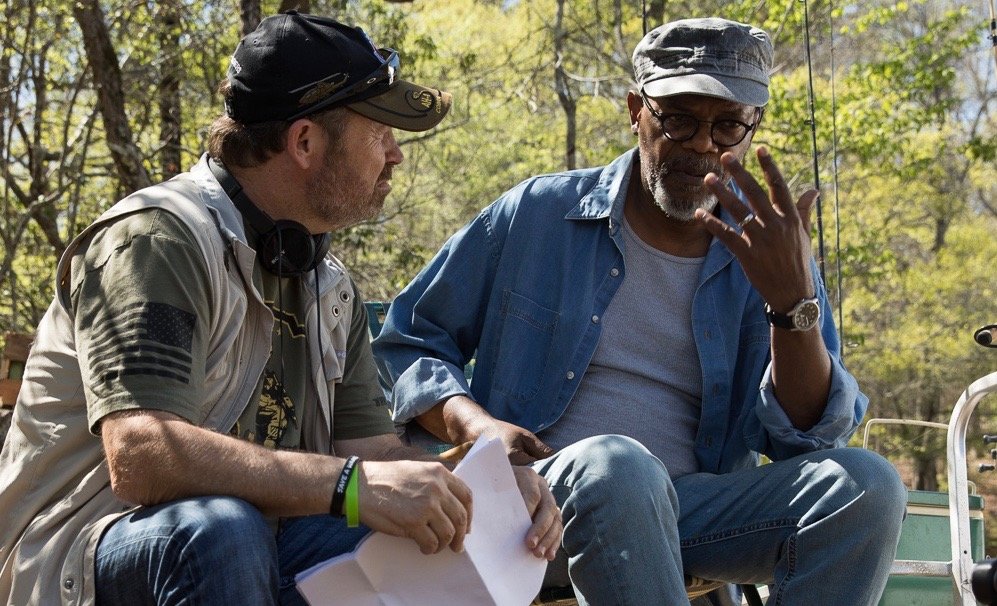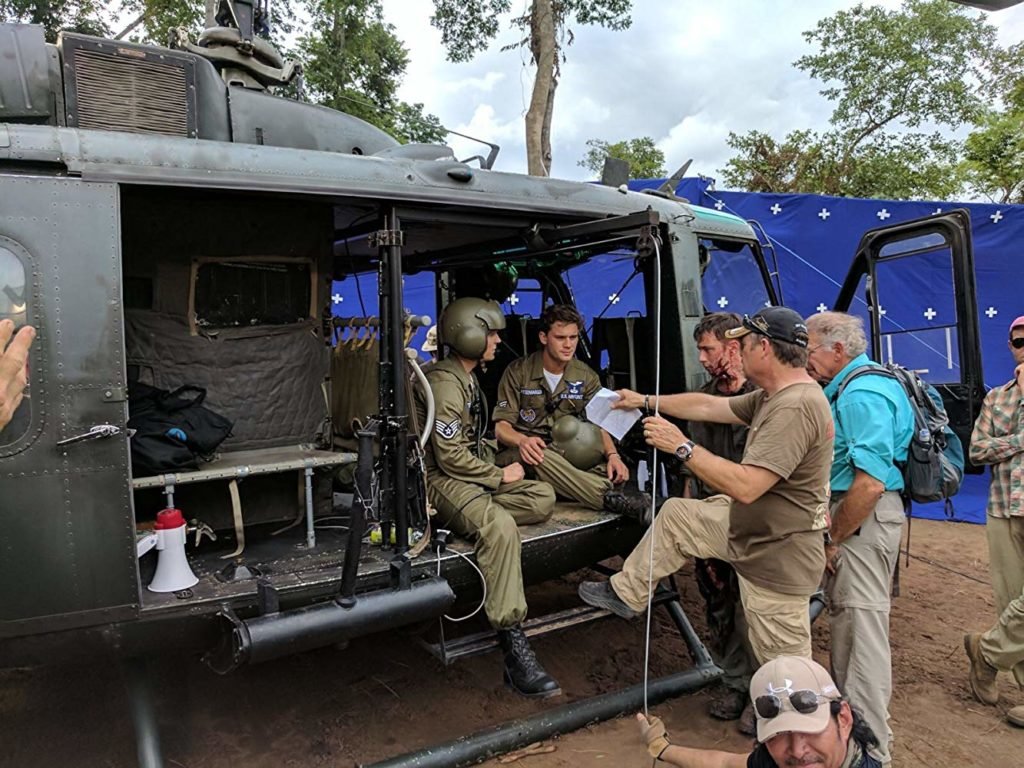Director of ‘The Last Full Measure’ Proud to Meet Vietnam Veterans for Film

Director Todd Robinson on the set of “The Last Full Measure” in Thailand. Photo courtesy of IMDb.
“The Last Full Measure” (2019) is a film about Medal of Honor recipient William Pitsenbarger, a pararescueman who was killed in action in 1966 in Vietnam. While most war films take the perspective of the service member knee-deep in combat, this one approaches battle from the viewpoint of Scott Huffman, who is investigating Pitsenbarger for the Medal of Honor years after the PJ’s death.
Most people haven’t experienced combat the likes of which Pitsenbarger saw, so, like Huffman, we are on the outside looking in. As he interviews the men who fought next to Pitsenbarger, now older and on to new chapters of their lives, the audience discovers the bond they share and the profound effect one act of heroism had on all of them.
During a recent interview with Coffee or Die, Todd Robinson, the writer and director of “The Last Full Measure,” recounted the obstacles of film production. They had to source funds and find suitable filming locations for the battle scenes. Scheduling A-list actors such as Samuel L. Jackson, Ed Harris, Christopher Plummer, Sebastian Stan, Dale Dye, and William Hurt certainly wasn’t easy. Yet Robinson and his crew overcame these difficulties — still, among the victories of production, Robinson was clear: “The thing that I’m most proud of are the friends I made who were veterans of that battle.”

Like Huffman, Robinson didn’t have a military background when he set out to learn the story of William Pitsenbarger. It started with his passion for flying, which brought him into some aviation circles — and naturally such circles are teeming with former military pilots. He thought he had a handle on flying, then all of a sudden these veterans were ratcheting up the intensity — one took him for a ride in his F4 Phantom to fly aerobatics.
“First day, I’m upside down, 18 inches from the other airplane,” Robinson said.
It was in these circles that Robinson found something he hadn’t felt before, beyond the adrenaline and awe of aircraft. Robinson began to pick up on their sense of brotherhood. And with that brotherhood came a long history filled with violence, courage, and fallen friends. He noticed that one story continuously resurfaced: “Everywhere I went, every airman wanted to tell the story of Pits (Pitsenbarger).”
Eventually, Robinson attended a pararescue graduation — the end of a long and arduous pipeline for some of the most elite operators on today’s battlefield. The guest speaker was William Pitsenbarger’s father. “As he spoke, I was captivated and moved,” Robinson said.

It was many years before “The Last Full Measure” film would become a reality, but before he could start writing, Robinson needed to do research. At the very least, he had to understand the mechanics of the battle and what had happened at a physical level.
“In doing the research for this whole thing, I met a young man, a researcher. He was going in and interviewing these vets who had been separated [from each other] for years,” Robinson said. “I met with [the researcher], just trying to figure out where to look for things. He said, ‘If you really want this story, you should talk to these guys, not me.’ He gave me this list, and I went around the country and met 15 of these Vietnam vets who were there in that battle. [The researcher] was the first guy and I was the second guy these guys had ever told this story to. And they were deeply emotional — these tough guys — in a restaurant full of people, just sobbing. I thought, Wow, that takes guts.”
These veterans had a clear and distinct impact on Robinson and, as a result, were a clear strength of “The Last Full Measure.” Hollywood has a tendency to paint the veteran community with broad strokes — whether that’s as gun-toting badasses, broken and fragile shells of their former selves, or an odd mix between stoic and alcoholic, there’s generally one category represented per movie. Robinson portrays no such simplicity — there’s the man who was mentally scarred by one of the worst engagements in Vietnam, the successful politician, the heartbroken but ultimately well-rounded family man, the bus driver who likes to shoot guns on the weekends, and the jungle dwelling hippie. All of these men have gone on with their lives and coped in different ways, some more successfully than others. None of them are the same, and that diversity is a shining jewel of the film.
Robinson became a student of these men’s experiences, listening with an intent ear in order to tell the story the right way. “You go in, you get highly trained, you put service before self, you go over there and have the most intense experiences doing things that they never trained you for,” Robinson said. “You go to war, you have this tribe, all this stuff happens — then your time is up.” He added that the men came back to see their family and friends, whose lives have been going on while they were at war, and it made them feel like outsiders. Or, as Samuel L. Jackson’s character in the movie says, “a refugee in my own country.”
“The Last Full Measure” also tackles the burden that these veterans bear. While some have forged successful, functional lives, a battle like the one that killed Pitsenbarger often leaves a scar. Those harrowing times forced men to do terrible things to survive, and “The Last Full Measure” depicts that struggle in various ways. But Robinson said the burden is one that they continue to carry while back home.
“In reality, the warrior is confusing and conflating what they had to do in the war with who they are as a person,” he said. That struggle is not unique to that battle or the Vietnam War — it exists in the lives of some combat veterans today as well.

It’s that drive and care for veterans that led Robinson to “Save a Warrior” (SAW), a nonprofit that “is like a war detox for veterans with suicidal ideation,” he said. The program is led by Jake Clark, a U.S. Army veteran, former Secret Service agent, and former FBI agent — in short, Clark is no stranger to the community he serves. According to their website, SAW is “committed to ending the staggering suicide rate plaguing our veterans, active-duty military and first responders. We conceive, originate and produce Integrated Intensive Retreat (IIR) program experiences to transform the way our heroes live their lives.” Robinson is a board member.
“We can’t exist without a standing military,” Robinson said flatly. While the film is a product of his gratitude for the veteran community, he doesn’t see “The Last Full Measure” as having much of anything to do with himself.
Instead, there are two things you can take away from the film. The first is that “service is greater than self,” Robinson said. “If you practice that, it grows empathy within you. Instead of focusing you inward, it focuses you outward. As you do that, you realize you’re getting more than you’re giving.”
The second core takeaway is that “anyone can make a difference,” he continued. “It’s the proverbial pebble in the pond. You have no idea where executing a random act of kindness will lead.”
“The Last Full Measure” is ultimately about William H. Pitsenbarger’s random act of kindness and the countless lives he affected with his heroism in the jungles of a foreign country. It’s about a 21-year-old man who truly lived the pararescue ethos: “These Things We Do, That Others May Live.”

Luke is the author of two war poetry books, The Gun and the Scythe and A Moment of Violence, and a post-apocalyptic novel, The First Marauder. He grew up in Pakistan and Thailand as the son of aid workers. Later, he served as an Army Ranger and deployed to Afghanistan on four combat deployments. Now he owns and operates Four Hawk Media, a social media-focused marketing company.
BRCC and Bad Moon Print Press team up for an exclusive, limited-edition T-shirt design!
BRCC partners with Team Room Design for an exclusive T-shirt release!
Thirty Seconds Out has partnered with BRCC for an exclusive shirt design invoking the God of Winter.
Lucas O'Hara of Grizzly Forge has teamed up with BRCC for a badass, exclusive Shirt Club T-shirt design featuring his most popular knife and tiomahawk.
Coffee or Die sits down with one of the graphic designers behind Black Rifle Coffee's signature look and vibe.
Biden will award the Medal of Honor to a Vietnam War Army helicopter pilot who risked his life to save a reconnaissance team from almost certain death.
Ever wonder how much Jack Mandaville would f*ck sh*t up if he went back in time? The American Revolution didn't even see him coming.
A nearly 200-year-old West Point time capsule that at first appeared to yield little more than dust contains hidden treasure, the US Military Academy said.












